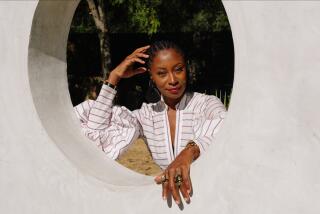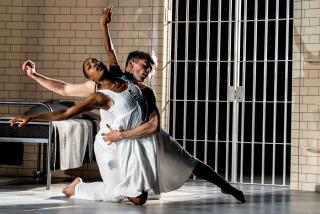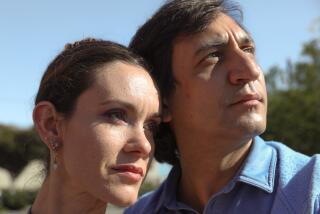Benjamin Millepied gets moving in Los Angeles
In a spacious dance studio at the Los Angeles Theatre Center, Benjamin Millepied, sporting a full beard and new wedding ring, kept springing up from his chair to experiment on his own body while figuring out the intricacies of a virtuosic duet between two of his male dancers. “Try this,” he told them and dropped to the floor into a bent-kneed, one-armed plank position that allowed him to do “10 seconds of abs.”
A few minutes later, he gave the thumbs-up to a capoeria-like spin on the forearms that one of the dancers attempted and brought a gasp from Millepied’s mother, visiting from Bordeaux, France. “My mother is appalled,” he announced to the room with a mischievous grin.
The former New York City Ballet dancer and choreographer of “Black Swan” fame seemed engaged in his own unique version of rebellion during a recent rehearsal for his new work “Moving Parts.” Chock-full of modern dance vocabulary and partnering maneuvers much closer to the world of contact improvisation than classical ballet, the dance will receive its world premiere Sept. 22 in a much-anticipated program at Walt Disney Concert Hall commissioned by and kicking off the 10th-anniversary season of Glorya Kaufman Presents Dance at the Music Center.
“This piece is totally a departure for me,” said Millepied, 35, who has created dances for American Ballet Theatre, Paris Opera Ballet and other top ballet companies. He has been praised by critics for his ability to create polished, architecturally complex work with large groups of dancers. A choreographer primarily concerned with the musicality of movement and the virtuosity of the body, he has also drawn criticism for sometimes displaying a lack of emotional depth and choreographic purposefulness.
Relocating to Los Angeles, he said, has allowed him to feel an unprecedented artistic freedom in which he can more fully embrace his early training in modern and African dance. “I feel like there’s space here in a way that can’t exist in New York, which is saturated with so many institutions. Also, I got to pick the dancers I wanted, and I feel limitless with them.”
Since forming L.A. Dance Project with financial backing from the Music Center in November, Millepied continues to defy easy categorization as a choreographer and artistic director of a new company intent on reaching out to the young and hip with a generalized interest in the arts while also appealing to established dance-goers. He has secured a slew of international bookings through 2014 and hired six dancers, all New York City transplants with considerable ballet training and modern dance credentials. And in calling L.A. Dance Project a collective, he has emphasized collaborations among visual artists, musicians and the film and television industry. This has included collaborating with the artist Mark Bradford at MOCA in July, creating a video featuring the street dancer Lil Buck and recently serving as a guest judge on the TV competition show “So You Think You Can Dance.”
“Today, you have to bring dance to people in a different way, where you can’t only be in Lincoln Center-type places,” Millepied said. “That scares most young people away.”
“Benjamin doesn’t draw the traditional lines between what’s commercial and what’s artistically authentic,” said Renae Williams Niles, the Music Center’s director of programming. “I think this is critical to his success here. He has this ability to be inspired by so many different elements, whether it’s working with professional ballet dancers or incorporating visual and film-based art.”
Millepied’s deliberate eschewing of, as he called it, “becoming yet another ballet company in the country that does classic repertory” reflects an ethos that has ample precedent in Los Angeles, where multiple choreographers have spent years presenting work in museums and other alternative venues while emphasizing interdisciplinary collaboration.
“What’s really interesting is that he’s getting the opportunity to do things in L.A. with big money behind him that people have been doing here for a long time,” said Jamie Nichols, a veteran local choreographer and executive producer of the annual Celebrate Dance showcase, who cites the site-specific work of Heidi Duckler and the interdisciplinary productions of Rosanna Gamson as but two examples.
L.A. Dance Project, however, has a golden opportunity to perform at Disney Hall — a Music Center venue offered in recent history only to a select few dance companies with international reputations such as Merce Cunningham and Shen Wei Dance Arts. Millepied specifically wanted to perform at Disney Hall instead of Dorothy Chandler Pavilion or the Ahmanson Theatre — venues where the Music Center normally presents dance. “It’s the most interesting of those spaces and also the most difficult to perform in because architecturally it imposes so much,” he said.
The Disney Hall program, in addition to Millepied’s world premiere, includes a revival of Merce Cunningham’s 1964 “Winterbranch” and William Forsythe’s 1993 “Quintett.” These works by two renowned American choreographers “make a statement,” Millepied said about the work he wants to present as an artistic director. “This is an American program, and I’m not here to do Tchaikovsky. … I mean, Tchaikovsky is great, but I’m … here to present work I believe in.”
Sitting in the lobby outside his large but sparsely decorated office at LATC, where he set up headquarters in July, Millepied came across as cordial yet guarded. (All he’ll say about recently marrying actress Natalie Portman is that he’s a family man with a day job who leads a normal life.) As he politely answered questions, he veered from the succinct to the elusive. When asked, for example, why he recruited New York City-based dancers to join his company after holding a November audition in Los Angeles, he said: “Dancers in any given company today are from all over the world, and I will hire the best dancers I can find. And my dancers are now L.A.-based dancers.” Millepied reiterated his commitment to creating a company with a uniquely “L.A. identity.” And for now, his answer to the skeptics is: “What’s ‘New York’ about New York City Ballet? What’s ‘San Francisco’ about the San Francisco Ballet?”
“Look, I know our first project isn’t actually a collection of L.A.-based artists,” he said of the Disney Hall premiere, which features music by his longtime collaborator Nico Muhly and art by the painter Christopher Wool, both New York-based. “What’s important is that I’m investing in this city, and I want to find the artists here that interest me.”
In the meantime, the local dance community has greeted Millepied’s presence with a mixture of hope and suspicion, especially after the choreographer chose not to hire dancers who already live in Los Angeles. “He is the real deal and I am in support of what he’s doing here but I think we all have some questions about whether or not he will connect to our community. It’s all just a little cryptic right now,” says Nichols, who adds there’s a “significant talent pool” of dancers in Los Angeles that, given the opportunity, would be able to do the work by choreographers of Millepied’s caliber.
Historically, Los Angeles has proven a tough town for sustaining internationally recognized dance companies, but Millepied has “all the right ingredients for making something happen here,” said Fred Strickler, professor emeritus and co-founder of the dance department at UC Riverside and chair of the new Dance History Project of Southern California.
“But it’s one thing to be in a place and simply bring your expertise to it and something else entirely to attach yourself to the pulse of a city and its various heartbeats. Even Balanchine needed years in New York before he really made it.”
Millepied doesn’t seem too concerned about his prospects for long-term success. “I don’t think this is unattainable by any means,” he said. “Right now, I just feel a great sense of responsibility to my dancers, to feed them with the best possible work. That’s the pressure.”
More to Read
The biggest entertainment stories
Get our big stories about Hollywood, film, television, music, arts, culture and more right in your inbox as soon as they publish.
You may occasionally receive promotional content from the Los Angeles Times.






